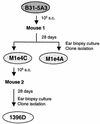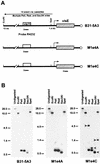Genetic variation of the Borrelia burgdorferi gene vlsE involves cassette-specific, segmental gene conversion
- PMID: 9673251
- PMCID: PMC108404
- DOI: 10.1128/IAI.66.8.3698-3704.1998
Genetic variation of the Borrelia burgdorferi gene vlsE involves cassette-specific, segmental gene conversion
Abstract
The Lyme disease spirochete Borrelia burgdorferi possesses 15 silent vls cassettes and a vls expression site (vlsE) encoding a surface-exposed lipoprotein. Segments of the silent vls cassettes have been shown to recombine with the vlsE cassette region in the mammalian host, resulting in combinatorial antigenic variation. Despite promiscuous recombination within the vlsE cassette region, the 5' and 3' coding sequences of vlsE that flank the cassette region are not subject to sequence variation during these recombination events. The segments of the silent vls cassettes recombine in the vlsE cassette region through a unidirectional process such that the sequence and organization of the silent vls loci are not affected. As a result of recombination, the previously expressed segments are replaced by incoming segments and apparently degraded. These results provide evidence for a gene conversion mechanism in VlsE antigenic variation.
Figures





References
-
- Ausubel F M, Brent R, Kingston R E, Moore D D, Seidman J G, Smith J A, Struhl K. Current protocols in molecular biology. New York, N.Y: John Wiley & Sons; 1996.
-
- Barbour A G. Antigenic variation of a relapsing fever Borrelia species. Annu Rev Microbiol. 1990;44:155–171. - PubMed
-
- Barbour A G, Burman N, Carter C J, Kitten T, Bergstrom S. Variable antigen genes of the relapsing fever agent Borrelia hermsii are activated by promoter addition. Mol Microbiol. 1991;5:489–493. - PubMed
-
- Borst P, Geaves D R. Programmed gene rearrangements altering gene expression. Science. 1987;235:658–667. - PubMed
-
- Donelson J E. Mechanisms of antigenic variation in Borrelia hermsii and African trypanosomes. J Biol Chem. 1995;270:7783–7786. - PubMed
Publication types
MeSH terms
Substances
Associated data
- Actions
Grants and funding
LinkOut - more resources
Full Text Sources
Other Literature Sources
Medical
Research Materials

